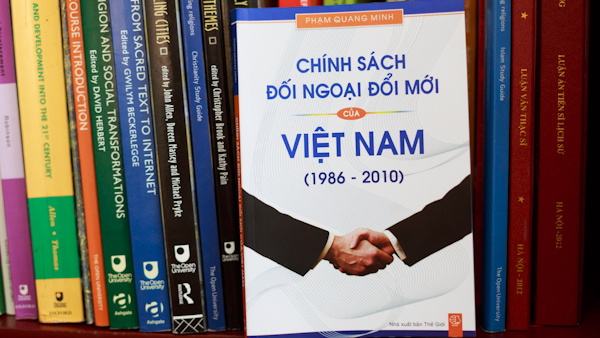USSH respectfully introduces the new book "Vietnam's Renewal Foreign Policy (1986-2010)" by Associate Professor, Dr. Pham Quang Minh. The book is 212 pages thick, printed in 500 copies, priced at 48,000 VND, published by The Gioi Publishing House in 2012.
In the decade (1975-1985) after the end of the Resistance War against the US, Vietnam faced a deep and comprehensive economic, political and social crisis. The victory in the resistance war against foreign invaders was not promoted in the period of economic construction and development. The cause of this situation was partly due to the severe devastation of war and natural disasters, but also partly due to the consequences of international relations issues related to Vietnam's policies towards countries including the Soviet Union, the US, China and neighboring countries in Southeast Asia. Since the mid-1980s, changes taking place not only within Vietnam but also on the regional and global scale have opened up new prospects for open and effective international relations between Vietnam and its partners. From Vietnam's perspective, the biggest change during that time was the decision to implement the renovation policy officially approved by the 6th Congress of the Communist Party of Vietnam in 1986. During that short period of time, the country underwent many changes in politics, economy, culture, society and especially foreign relations. From a member country of the Socialist bloc, having only economic relations with countries in the Council for Mutual Economic Assistance (SEV) and considering relations with the Soviet Union as the "cornerstone" of its foreign policy, in 1995 Vietnam became a member of ASEAN, ASEM in 1996, APEC in 1998, WTO in 2007 and a non-permanent member of the United Nations Security Council in 2008. How could a country like Vietnam have such dramatic changes in such a short time? Up to now, there are still many different opinions about the causes, content and results of Vietnam's foreign policy innovation. The first group of opinions believes that the innovation in Vietnam's foreign policy is only a situational response to the rapid developments of the world situation, not a proactive, calculated and carefully prepared perception in advance. The second group of opinions believes that the results that Vietnam has achieved in its foreign policy, although impressive, are still limited and do not fully reflect the country's potential. The third group of opinions believes that, although it has implemented the foreign policy innovation for 25 years, Vietnam is still confused, does not have a clear foreign strategy and appropriate policies when the world and regional situation is changing rapidly and complicatedly.

With the aim of contributing to clarifying the above questions, this book will analyze the process of formation, movement and development of Vietnam's foreign policy of renovation from 1986 to 2010, thereby evaluating the outstanding achievements, drawing lessons, and pointing out the limitations that need to be overcome, in order to perfect foreign policy in the coming time. With that purpose, the book will consist of three chapters: Chapter one: Causes of the formation of foreign policy of renovation. This chapter focuses on analyzing the factors affecting the process of forming foreign policy of renovation as the basis for understanding why the Communist Party of Vietnam made the decision to innovate in general, and foreign policy in particular, in 1986. Chapter 2: The process of formation and development of Vietnam's foreign policy of renovation from 1986 to 2010. The main content of chapter 2 is to systematically present from a historical perspective the process of forming Vietnam's foreign policy from 1986-2010, through analyzing the basic content of documents of party congresses and other documents of the Party to answer the question: what are the basic contents of the reformed foreign policy, how was it formed and adjusted through each stage. Chapter 3: Results of implementing the reformed foreign policy. This chapter focuses on evaluating the achievements that Vietnam's reformed foreign policy has made in both cognitive and practical aspects. On that basis, chapter 3 also draws some lessons and makes some recommendations to contribute to implementing the reformed foreign policy more effectively.

